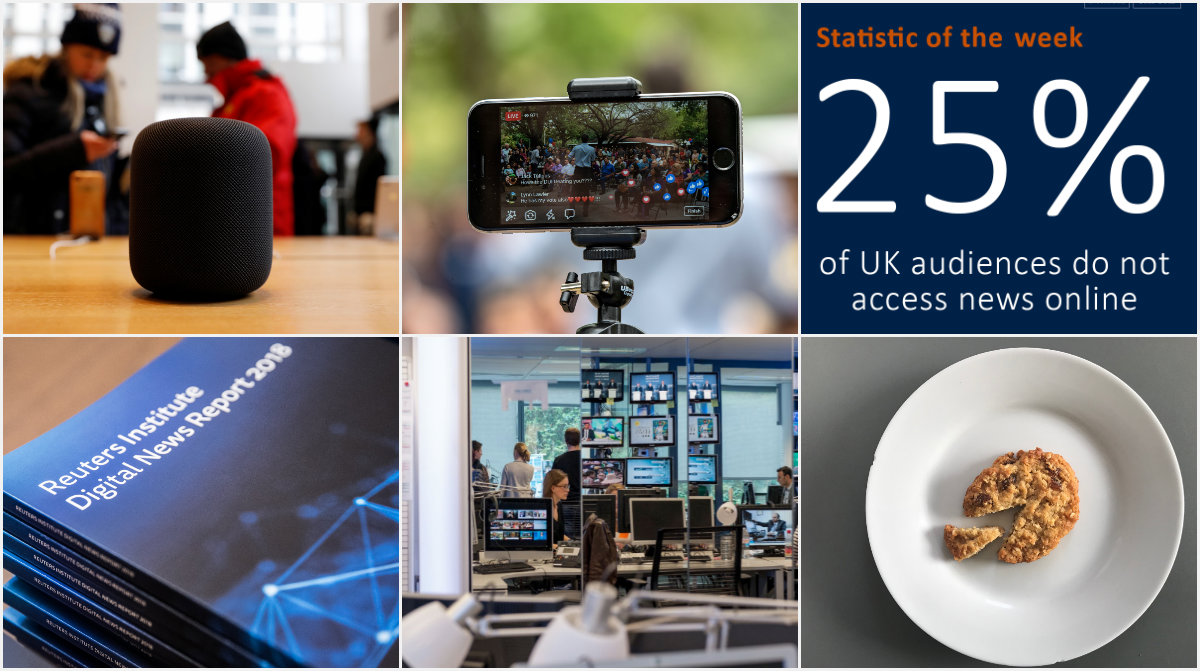Disinformation, fact-checking, local news, inequality, voice, 'shiny things'...and the Digital News Report: 10 research highlights of 2018

During 2018 Reuters Institute has conducted research into some of the most pressing issues in the media landscape. From disinformation to automated fact-checking, from social media to social inequality, and from global collaboration to local news.
Over the past twelve months we have focused on the challenges of digital transition faced by both public and private sector media. These included an examination of how outlets are using social media to distribute news, and the impact of algorithm change upon the relationship with social media platforms.
The Digital News Report, launched in June, is the world’s largest international comparative study tracking online news access and engagement over 37 countries. The 2018 report found fewer people using Facebook for news, especially in countries affected by public debate over misinformation. At the same time the use of messaging apps for news has doubled to 16% in the last four years. The report also looked at issues of trust, new online business models, and the rise of new platforms.
2018 was the year of General Data Protection Regulation (GDPR) in Europe. The new legislation reflected growing public concerns about privacy and online security. Two Reuters Institute reports, by Timothy Libert, examined the high-levels of third-party content on Europe’s news sites, and how this (slightly) diminished after the introduction of GDPR.
Is voice the next big thing in news? Maybe not… yet. A report by Nic Newman found that the use of voice-activated devices and smart speakers is increasing in the UK and US, but only 1% of users currently access news via their devices. Nic Newman concluded that this statistic could rise as the devices begin to reach mainstream audiences.
But, is journalism too focused on the next ‘shiny thing’? At the end of the year, a study published to launch the new Journalism Innovation Project, by Julie Posetti, ‘Time to Step Away from the Bright Shiny Things? Towards a sustainable model of journalism innovation in an era of perpetual change,’ argued that journalism should change from being technology-led to audience-focused and technology-empowered.
Below, we list ten key reports from 2018. All are available to download, free, from our site.
1. Global Teamwork: The Rise of Collaboration in Investigative Journalism
Journalism, a naturally competitive profession and business, is increasingly embracing collaboration, and while not easy, high-profile collaborative investigations (enabled by trust, technology, and independent third parties) can deliver editorial, commercial, and public value, as Richard Sambrook and the other contributors to “Global Teamwork: The rise of collaboration in investigative journalism” shows. Read more about the book >>
2. Understanding the Promise and Limits of Automated Fact-Checking (factsheet)
The last two years have seen mounting enthusiasm for automated fact-checking systems as a weapon in the fight against online misinformation. Despite rapid progress, though, the promise of these technologies is still mainly as tools to help human fact-checkers do their jobs, Lucas Graves argues. Read more and download the factsheet >>
3. Public Service News and Social Media (Digital News Project report)
While public service media across Europe pursue different strategies for news distribution on social media (on- site versus offsite-strategies) and have different levels of investment in social media, tactically, their social media teams work in relatively similar ways. This is largely because they respond to similar incentives from platforms and try to imitate what they see as best practice elsewhere as Annika Sehl and co-authors of Public Service News and Social Media show. Read more and download the report >>
4. Digital Transition of Local News (Digital News Project report)
Local and regional newspapers around Europe are pursuing ambitious strategies for producing and monetizing digital news, as Joy Jenkins and Rasmus Kleis Nielsen show in “The Digital Transition of Local News.” Through centralizing online content production, reorganizing newsrooms to emphasize digital-first approaches, diversifying their business models, and rethinking their relationships with their audiences, local media are working to move beyond a declining print business to invest in a digital future. Read more and download the report >>
5. Digital News Report 2018
Facebook has been hit by concerns over privacy, ‘fake news’, and toxic debates with more discussion and debate moving to younger networks and private messaging apps. This was one of the main stories in this year's Digital News Report, which suggested that this was pushing some news organisations to refocus on quality journalism and content that could be charged for online. Watch the 3-minute video and visit the Digital News Report website >>
6. Third-Party Web Content on EU News Sites (factsheet) / Changes in 3rd-Party Content on European News Websites after GDPR (factsheet)
European news sites are deeply intertwined with a wider digital advertising and media ecosystem that involves data collection and sharing with numerous third-parties, sometimes without disclosing this to users, especially advertising-reliant news sites have very high levels of third-party content and cookies (though the numbers have declined after GDPR), a team led by Timothy Libert shows. Read more and download the factsheets (original factsheet | follow-up factsheet).
7. Private Sector News, Social Media Distribution, and Algorithm Change
Even though news organisations are frustrated by limited monetisation opportunities and frequent algorithm changes, their social media strategies remain concentrated on Facebook. Business models largely shape approaches to platforms and responses to changes, as Alessio Cornia and other contributors to Private Sector News, Social Media Distribution, and Algorithm Change show. Read more and download report >>
8. Social inequality in news use (factsheet)
There is greater social inequality in online than in offline news consumption in the UK, as Antonis Kalogeropoulos and Rasmus Kleis Nielsen find in “Social Inequalities in News Consumption”. In the future social inequality is likely to increase as we continue to move to a more digital media environment. Read more and download factsheet >>

9. Future of Voice
Voice-activated speakers are beginning to reach mainstream audiences, but news consumption remains limited for now. Publishers fear that voice platforms could be a new ‘choke point’ for access to their brands and are also concerned about access to data and opportunities to monetise content. These are conclusions for the first major study of news consumption on voice platforms like Amazon (Alexa) and Google (Assistant). Read more and download report >>
10. Innovation report 1 (Journalism Innovation Project)
News industry leaders are increasingly wary of 'Bright Shiny Things Syndrome' – a journalism innovation strategy based on ‘random acts of innovation’ without a clear set of research-informed goals and objectives. This approach distracts from core journalistic functions, can lead to burnout and fatigue, and risks stagnation or innovation paralysis, as detailed in Julie Posetti’s report on crafting sustainable approaches to journalism innovation. Read more and download report >>
For more about the work of the Reuters Institute download our Annual Report 2017-2018



